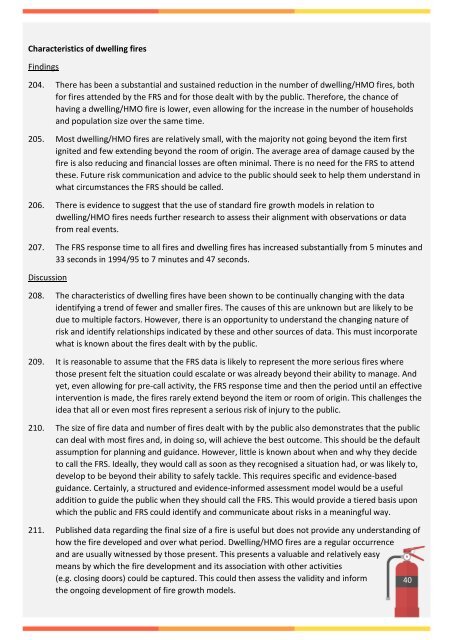An evaluation of the role of fire extinguishers
A report considering the role of a fire extinguisher in human terms identifying the gap between policy assumptions and the evidence from real fires. It considers the implications arising from this and makes a number of recommendations to create an evidence base and enhance current fire safety policies/advice.
A report considering the role of a fire extinguisher in human terms identifying the gap between policy assumptions and the evidence from real fires. It considers the implications arising from this and makes a number of recommendations to create an evidence base and enhance current fire safety policies/advice.
Create successful ePaper yourself
Turn your PDF publications into a flip-book with our unique Google optimized e-Paper software.
Characteristics <strong>of</strong> dwelling <strong>fire</strong>s<br />
Findings<br />
204. There has been a substantial and sustained reduction in <strong>the</strong> number <strong>of</strong> dwelling/HMO <strong>fire</strong>s, both<br />
for <strong>fire</strong>s attended by <strong>the</strong> FRS and for those dealt with by <strong>the</strong> public. Therefore, <strong>the</strong> chance <strong>of</strong><br />
having a dwelling/HMO <strong>fire</strong> is lower, even allowing for <strong>the</strong> increase in <strong>the</strong> number <strong>of</strong> households<br />
and population size over <strong>the</strong> same time.<br />
205. Most dwelling/HMO <strong>fire</strong>s are relatively small, with <strong>the</strong> majority not going beyond <strong>the</strong> item first<br />
ignited and few extending beyond <strong>the</strong> room <strong>of</strong> origin. The average area <strong>of</strong> damage caused by <strong>the</strong><br />
<strong>fire</strong> is also reducing and financial losses are <strong>of</strong>ten minimal. There is no need for <strong>the</strong> FRS to attend<br />
<strong>the</strong>se. Future risk communication and advice to <strong>the</strong> public should seek to help <strong>the</strong>m understand in<br />
what circumstances <strong>the</strong> FRS should be called.<br />
206. There is evidence to suggest that <strong>the</strong> use <strong>of</strong> standard <strong>fire</strong> growth models in relation to<br />
dwelling/HMO <strong>fire</strong>s needs fur<strong>the</strong>r research to assess <strong>the</strong>ir alignment with observations or data<br />
from real events.<br />
207. The FRS response time to all <strong>fire</strong>s and dwelling <strong>fire</strong>s has increased substantially from 5 minutes and<br />
33 seconds in 1994/95 to 7 minutes and 47 seconds.<br />
Discussion<br />
208. The characteristics <strong>of</strong> dwelling <strong>fire</strong>s have been shown to be continually changing with <strong>the</strong> data<br />
identifying a trend <strong>of</strong> fewer and smaller <strong>fire</strong>s. The causes <strong>of</strong> this are unknown but are likely to be<br />
due to multiple factors. However, <strong>the</strong>re is an opportunity to understand <strong>the</strong> changing nature <strong>of</strong><br />
risk and identify relationships indicated by <strong>the</strong>se and o<strong>the</strong>r sources <strong>of</strong> data. This must incorporate<br />
what is known about <strong>the</strong> <strong>fire</strong>s dealt with by <strong>the</strong> public.<br />
209. It is reasonable to assume that <strong>the</strong> FRS data is likely to represent <strong>the</strong> more serious <strong>fire</strong>s where<br />
those present felt <strong>the</strong> situation could escalate or was already beyond <strong>the</strong>ir ability to manage. <strong>An</strong>d<br />
yet, even allowing for pre-call activity, <strong>the</strong> FRS response time and <strong>the</strong>n <strong>the</strong> period until an effective<br />
intervention is made, <strong>the</strong> <strong>fire</strong>s rarely extend beyond <strong>the</strong> item or room <strong>of</strong> origin. This challenges <strong>the</strong><br />
idea that all or even most <strong>fire</strong>s represent a serious risk <strong>of</strong> injury to <strong>the</strong> public.<br />
210. The size <strong>of</strong> <strong>fire</strong> data and number <strong>of</strong> <strong>fire</strong>s dealt with by <strong>the</strong> public also demonstrates that <strong>the</strong> public<br />
can deal with most <strong>fire</strong>s and, in doing so, will achieve <strong>the</strong> best outcome. This should be <strong>the</strong> default<br />
assumption for planning and guidance. However, little is known about when and why <strong>the</strong>y decide<br />
to call <strong>the</strong> FRS. Ideally, <strong>the</strong>y would call as soon as <strong>the</strong>y recognised a situation had, or was likely to,<br />
develop to be beyond <strong>the</strong>ir ability to safely tackle. This requires specific and evidence-based<br />
guidance. Certainly, a structured and evidence-informed assessment model would be a useful<br />
addition to guide <strong>the</strong> public when <strong>the</strong>y should call <strong>the</strong> FRS. This would provide a tiered basis upon<br />
which <strong>the</strong> public and FRS could identify and communicate about risks in a meaningful way.<br />
211. Published data regarding <strong>the</strong> final size <strong>of</strong> a <strong>fire</strong> is useful but does not provide any understanding <strong>of</strong><br />
how <strong>the</strong> <strong>fire</strong> developed and over what period. Dwelling/HMO <strong>fire</strong>s are a regular occurrence<br />
and are usually witnessed by those present. This presents a valuable and relatively easy<br />
means by which <strong>the</strong> <strong>fire</strong> development and its association with o<strong>the</strong>r activities<br />
(e.g. closing doors) could be captured. This could <strong>the</strong>n assess <strong>the</strong> validity and inform<br />
<strong>the</strong> ongoing development <strong>of</strong> <strong>fire</strong> growth models.<br />
40<br />
38




